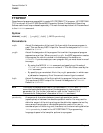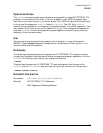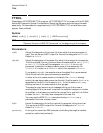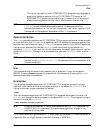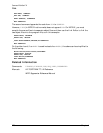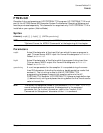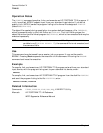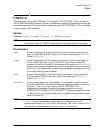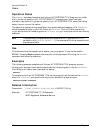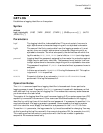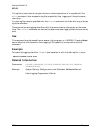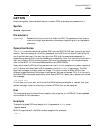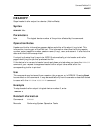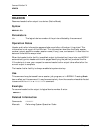
Chapter 4 273
Command Definition F-K
FTNXLLK
FTNXLLK
Compiles and links an HP FORTRAN 77/iX program. HP FORTRAN 77/iX is not part of
the HP 3000 Series 900 Computer System Fundamental Operating Software and must be
purchased separately. This command is recognized only if HP FORTRAN 77/iX is installed
on your system. (Native Mode)
Syntax
FTNXLLK[ textfile][,[progfile][,[listfile] ] ] [ ;INFO=quotedstring]
NOTE This command follows the optional MPE/iX command line syntax. Refer to
"Optional Format for MPE/iX Commands" at the beginning of this chapter.
Parameters
textfile Actual file designator of the input file from which the source program is
read. This can be any ASCII input file. Formal file designator is FTNTEXT.
Default is $STDIN.
progfile Actual file designator of the program file to which the linked program is
written. When you omit progfile, the MPE/iX Link Editor creates the
program file, which is stored in the temporary file domain as $OLDPASS. If
you do create your own program file, you do so by specifying a nonexistent
file in the progfile parameter, in which case a job/session permanent file of
the correct size and type is created.
listfile Actual file designator of the file to which the program listing is written.
This can be any ASCII output file. Formal file designator is FTNLIST.
Default is $STDLIST.
quotedstring A run-time parameter for the compiler. It is a quoted string of no more
than 255 characters (including the single or double quotation marks that
enclose it). The info string is used in the HP FORTRAN 77/iX
programming language to pass initial compiler options to the HP
FORTRAN 77/iX compiler. HP FORTRAN 77/iX places a single dollar sign
($) before the info string and places the string before the first line of source
code in the text file.
NOTE The formal file designators used in this command (FTNTEXT, FTNOBJ, and
FTNLIST) cannot be backreferenced as actual file designators in the
command parameter list. For further information, refer to the "Implicit FILE
Commands for Subsystems" discussion of the FILE command.




